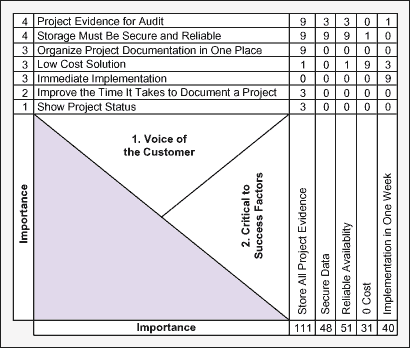
A significant part of business success can come from the speed and quality of decision-making. Such good decision-making leads to performance improvements by reducing rework and driving benefits to the bottom line faster. Six Sigma, especially Design for Six Sigma (DFSS), has tools that improve the speed and quality of decisions. A morphological matrix will help identify potential solutions and define functional requirements for each solution. A Pugh matrix will help rank potential solutions against the voice of the customer (VOC).
These methods are best illustrated with a hypothetical case study involving team decision making.
A team has formed to quickly identify a solution for storing Six Sigma project documentation. The documentation needs to be made available for project audits. Decision speed and quality are crucial since the company has just begun to deploy Six Sigma. As the team begins its work, members are split among three potential solutions. While reluctant to give up their individual preferences, team members realize the wrong decision could result in adding time and expense to project documentation.
Four Steps to the Best Solution
To overcome this impasse and reach a good decision quickly, the team decides to use a four-step approach:
- Gather the voice of the customer (VOC).
- Translate critical-to-success factors (CTXs) from VOC.
- Use morphological matrix to determine potential solutions and functional requirements.
- Use Pugh matrix to evaluate potential solutions against VOC.
None of the steps should be overly time-consuming. The most time should be spent on gathering the voice of the customer. Since decision quality is making the decision which best addresses the problem, the team must have the best data possible from customers. A decision based on inadequate data will be a poor decision. A decision which addresses all customers’ needs is a quality decision.

Step 1 – The team begins by pulling in key customers and documenting their wants and needs regarding Six Sigma project documentation. There are a variety of ways to gather customer information. Typically, one-on-one interviews or group forums are used to discuss wants and needs. Also, a good survey can get at key customer information. Regardless of how VOC-gathering is addressed, two things should be kept in mind:
- A good Black Belt or Green Belt asks the customer. No one should assume they know what the customer wants.
- Organize the voice of the customer in terms of:
- “Must haves” – What this solution must do.
- “One-dimensional” or “The more of something the better” – Think about gas mileage in a car; the more fuel efficient the car, the better.
- “Delighters” – The things that the customer did not specifically ask for but will be a delight to find that the solution provides.
In Figure 1, the team has gathered the VOC. The customers said that the solution must store project evidence for audit and the storage must be secure and reliable. In terms of one-dimensional, the customers said, “the lower the cost, the better” and “the faster the implementation, the better.” And finally, there were two delighters that the customer eluded to but did not directly come out and ask for: It would be great if the solution could improve the time it takes to document a project and could show project status.
Are the Customers’ Needs Being Met?
Step 2 – After the team captures the voice of the customer, it needs to establish a way to measure that the business is meeting the customers’ needs. Critical-to-success factors are measurable characteristics that directly correlate to a specific VOC item. When measuring the CTXs, there are two different types of data – variable and attribute. (Variable data = data that can be measured, such as hours, length, weight, etc. Attribute data = data that is categorized, such as pass/fail, straight/bent, color, etc.) Try to establish variable data measurements whenever possible. However, there may be times where a product or service needs to meet a yes-no standard. That would be attribute data.
Step 3 – The team now has determined what the customer wants, and how it is going to measure if the customers’ needs are being met. The team moves into the next phase – collecting information on potential solutions. It is not uncommon to see a change in the team’s opinion of solutions at this point. Working with the customers’ requirements and seeing the problem through the customers’ eyes makes some solutions begin to stand out. The team can now begin to determine how potential solutions will fulfill customer requirements.
| Figure 2: Morphological Matrix | |||
|
Voice of the Customer |
Functional Requirements |
||
|
File System |
Website |
Doc.Mgt.Sys. |
|
| Project Evidence for Audit | Build a folder system to store project documentation. | Build a website to store the project documentation. | Use a document management system (DMS) to store project documentation. |
| Storage Must Be Secure and Reliable | Document storage must be kept on an IT server that is robust and backed up. Permissions will be managed by IT. | Document storage must be kept on an IT web server that is robust and backed up. Default permissions on a website are anonymous – to secure the website will take additional IT support. | Document storage must be kept on an IT web server that is robust and backed up. Permissions will be managed by DMS administrator. |
| Organize Project Documentation in One Place | Communicate to all project managers the location of the project documentation. | Communicate to all project managers the location of the project documentation. | Communicate to all project managers the location of the project documentation. |
| Low-Cost Solution | File system is a no-cost solution. | Website will require extra expense for permissions on the web server. | Licenses will need to be purchased for users of the DMS. |
| Immediate Implementation | File system set-up time required is about 24 hours. | Website set-up time required is about two weeks. | DMS set-up time required is as much as two months. In addition there may be a longer learning curve for users of the DMS. |
| Reduce Time It Takes to Document a Project | Create standard project documentation templates and setup. | Create standard project documentation templates and setup. | Create standard project documentation templates and setup. |
| Show Project Status | Create document to roll up project status. | Create document to roll up project status. (Will add additional expense) | Create document to roll up project status. |
A morphological matrix will help the team identify all applicable solutions and document how the solutions will address the customers’ needs. In Figure 2, the team carries over the voice of the customer and the three solutions. For each solution, the team defines how that solution will fulfill the voice of the customer. It also may be helpful to include product demonstrations so team members not familiar with all solutions are well-educated. The morphological matrix defines all the functional requirements for each solution.
Step 4 – The final step in the process is to rank each of the potential solutions by how well they can address the critical-to-success factors. In Figure 3, the team lists the critical-to-success factors and their importance from Figure 1. Then, the team decides on a datum. The datum could be any of the solutions. There are a couple of ways to approach this: 1) use the solution for a datum that is starting to stand out for the team or 2) use the solution that someone has been typically outspoken about. Either way, the results will be the same.
| Figure 3: Pugh Matrix | ||||
| Critical-to-Success Factors |
Importance |
File System |
Website |
Doc.Mgt.Sys. |
| Store All Project Evidence |
111 |
D |
S |
S |
| Reliable Availability |
51 |
A |
S |
S |
| Secure Data |
48 |
T |
– |
S |
| Implementation in One Week |
40 |
U |
– |
– |
| O Cost |
31 |
M |
– |
– |
| Minus (-) |
3 |
2 |
||
| Plus (+) |
0 |
0 |
||
| Same (S) |
2 |
3 |
||
| Analysis |
-3 |
-2 |
||
The real power behind a Pugh matrix is making the right decision based on data. Rank each solution against the datum for each critical-to-success factor. Three symbols are used for the comparison: S = same as datum, a minus sign (-) = worse than datum, and a plus sign (+) = better than datum. In Figure 3, all three solutions are roughly the same. The website is worse than the file system in three areas and the document management system is worse than the file system in two areas. Neither of the two solutions is better than the file system in any of the critical-to-success factors. The analysis field is figured by subtracting the number of minus signs from the number of plus signs. Anything positive would make that solution better than the datum and, as in our example, anything negative would determine the datum as a better solution.
Result: Best Solution and More
The final deliverable from this process is to make an educated decision. From the Pugh matrix, it is clear that a file system is the best solution. In addition, there are some positive side effects. The morphological matrix determines the functional requirements. When the team is ready to implement, the functional requirements have been determined. Furthermore, to improve the quality of decision making, the team could perform a risk assessment or failure mode and effects analysis (FMEA) on the selected solution.
Applying the Six Sigma tools to decision-making does not have to be a long, drawn-out process. In fact, an argument may be made that decision speed is improved because this process limits the solution arguments to team decisions based on data. And, importantly, the foundation for making the right decision is rooting the decision from the voice of the customer.